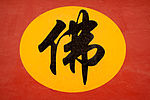| Part of a series on |
| Pure Land Buddhism |
|---|
 |
| Buddhas and bodhisattvas |
| Teachings |
| Practices |
| Scriptures |
Key figures
|
| Schools |
| Part of a series on |
| Chinese Buddhism |
|---|
 |
| History |
Major figures
|
| Traditions |
| Texts |
| Architecture |
| Sacred Sites |
| Culture |
Tánluán (Chinese: 曇鸞; Japanese pronunciation: Donran, 476–542) was a Chinese Buddhist monk who wrote on Pure Land Buddhism. Tánluán is considered to be the Third Patriarch of Pure land Buddhism by the Japanese Pure Land sects like Jōdo-shu and Jōdo Shinshū.
Life
Tánluán was originally a Buddhist scholar of the Sanlun school, but after becoming ill, he studied Taoism in order to seek the Pill of Immortality. However, he had a striking encounter with Bodhiruci, a Buddhist monk from India who had come to China to translate and transmit Mahayana sutras. When Tánluán asked him about finding immortality, Bodhiruci told him he would not find it here, and gave him a copy of the Amitayus Sutra, which teaches about the Pure Land of the Buddha "Measureless Life" (Amitayus). Tánluán then became a devotee of Pure Land Buddhism and burnt his Taoist texts.
Works
Tánluán wrote the influential Pure Land treatise Commentary on Treatise on the Pure Land (Jingtu lun zu, 浄土論註). The commentary taught that the all beings could be reborn in Sukhavati, the pure land of Amitābha, through sincere nianfo (recitation of a Buddha's name). His commentary also contains some of the earliest discussions of the Chinese Buddhist doctrine of other-power (tālì 他力).
According to Tánluán, other-power is "the dominant causal condition" (Sanskrit: adhipatipratyaya) for the attainment of complete Buddhahood:
On the path of easy practice, one simple aspires to the born in the Pure Land with faith in the Buddha as the cause. Carried by the power of the Buddha's Vow, one quickly attains birth in that Buddha's pure land. Sustained by the Buddha's power, one immediately enters the stage of the rightly settled of the Mahayana.
Tánluán also wrote Verses in Praise of Buddha Amitabha (讃阿弥陀仏偈, Zan Omituofoji) and a Condensed Commentary on the Significance of the Pure Land of Peace and Bliss (略論安楽浄土義). However some scholars question the authenticity of the Condensed Commentary.
Influence
Tánluán is influential in the history of Pure Land Buddhism since he was the first thinker to apply the term Other-power (Chinese: tālì 他力) to a Pure Land context.
Tánluán also had a strong impact on Daochuo, who once visited his temple. His work also influenced Shandao.
Tánluán's discussion of self-power and other-power clearly influenced the Japanese Pure Land traditions, who emphasize the other-power of the Buddha Amitabha as the only cause of rebirth in the Pure land. As such, Tánluán was seen by Hōnen and Shinran as the founder of Pure Land Buddhism in China. Tánluán's works were very influential on the Japanese Jōdo Shinshū school since they were relied upon by Shinran in his writings.
References
- UBC Asian Studies (2021-01-26). 2020 Annual Symposium: Other Power in Buddhism. Retrieved 2024-10-15 – via YouTube.
- ^ "The Five Pure Land Patriarchs". Koloa Jodo Mission- Buddhist Temple. Retrieved 2024-10-20.
- T'an-luan, Pruden, Leo (1975). A Short Essay on the Pure Land, The Eastern Buddhist, New Series 8 (1), 74-95
- ^ UBC Asian Studies (2021-01-26). 2020 Annual Symposium: Other Power in Buddhism. Retrieved 2024-10-15 – via YouTube.
- Foqing, Householder (2023). Commentary on the Treatise on Rebirth in the Pure Land.
- ^ UBC Asian Studies (2021-01-26). 2020 Annual Symposium: Other Power in Buddhism. Retrieved 2024-10-15 – via YouTube.
Literature
- Inagaki, Hisao : T'an-luan's Commentary on Vasubandhu's Discourse on the Pure Land, A Study and Translation ; Kyōto, Nagata Bunshōdō, 1998.
- Tanluan: Commentaire au Traité de la naissance dans la Terre Pure de Vasubandhu, texte établi, annoté et traduit par Jérôme Ducor (Bibliothèque chinoise, vol. 31); Paris, Les Belles Lettres, 2021; 310 pp. (ISBN 978-2-251-45089-6)
- Shinko Mochizuki, Leo M. Pruden,Trans. (2000). Pure Land Buddhism in China: A Doctrinal History, Chapter 7: T'an-luan. In: Pacific World Journal, Third Series, Number 2, 149–165. Archived from the original
- Yukio Yamada (2000). T'an-luan's Theory of Two Kinds of Dharma-body as Found in Shinran's Wago Writings, Pacific World Journal, Third Series, Number 2, 99-113. Archived from the original
- Ryusei Takeda (2000). The Theoretical Structure of "Birth in the Pure Land": Based on the Meaning of T'an-luan's "Birth through Causal Conditions", Pacific World Journal, Third Series, Number 2, 31–60. Archived from the original
- Shoji Matsumoto (1986). The Modern Relevance of Donran's Pure Land Buddhist Thought, Pacific World Journal New Series 2, 36-41
This article is a stub. You can help Misplaced Pages by expanding it. |
This article is a stub. You can help Misplaced Pages by expanding it. |
This article is a stub. You can help Misplaced Pages by expanding it. |